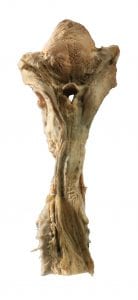Specimen of the Week 362: Acid Poisoning
By Subhadra Das, on 12 October 2018
Today’s specimen of the week comes from UCL Pathology Collections. The Collections are displayed at the UCL Pathology Museum at the Royal Free Campus of the UCL Medical School in Hampstead. The museum includes a medical teaching collection of nearly 3,000 specimens of human remains illustrating the history of disease. To open up these specialist medical displays to a wider audience, we’ve developed a trail of 10 specimens of well known diseases. As the museum only opens to the public for special events, we’re sharing the trail as part of the Specimen of the Week series.
All of the entries for the UCL Pathology Collections Top 10 Medical Trail have been written by Nazli Pulatmen, who worked with us for her MA Museum Studies placement in the summer of 2018.
Today’s specimens of the week are presented together because they show the effects of ingesting corrosive acids.
As can be seen the acids have caused devastating cell death – known medically as necrosis. The acids have caused fatal irreversible damage to the tissues they were exposed to, and would have resulted in death in a number of days. The oesophagus and stomach specimen is from a patient who drank sulphuric acid, and the tongue and oesophagus specimen shows hydrochloric acid poisoning. Both patients ingested the acids with the intention of committing suicide, but little else is known about them as the clinical notes accompanying the specimens does not include much of a patient history.
For the tongue and oesophagus specimen there is a short clinical note stating simply: ‘Patient died on the 4th or 5th day after swallowing “spirits of salt”.’ Many medical museums contain forensic specimens like these, without any documentation of the human story behind them. Suicide by ingesting acid is extremely rare and has mostly been documented in people suffering from extreme major depressive disorders and other mental health problems that cause suicidal ideation — the thoughts people have about killing themselves. These specimens encourage us to think about the real people from whom pathology museums cultivate their collections and they remind us of the diversity of circumstances in which human tissue becomes a part of museum display. Furthermore, these specimens hopefully encourage those viewing them to think about the effects and consequences of poor mental health support and understanding. These two specimens are extremely interesting and, at the same time, very sobering to view and it is a pity the clinical notes cannot offer us a little more information on the people from whom they are sourced.
You can find out more from this reference:
Rao, K. N., & Sudarshan, C. Y. (2015). Suicide due to sulfuric acid ingestion in a case of major depressive disorder. Indian Journal of Psychiatry, 57(2), 203–204. http://doi.org/10.4103/0019-5545.158195
One Response to “Specimen of the Week 362: Acid Poisoning”
- 1
 Close
Close




prof prem raj pushpakaran writes — John Brown Francis Herreshoff, the great metallurgical chemist who invented process for making Sulphuric Acid was born on February 7th, 1850!!!